The term “containment” never comes up, writes Michael T. Klare. But nonetheless, here is the new 21st century Cold War on a planet desperately in need of something else.
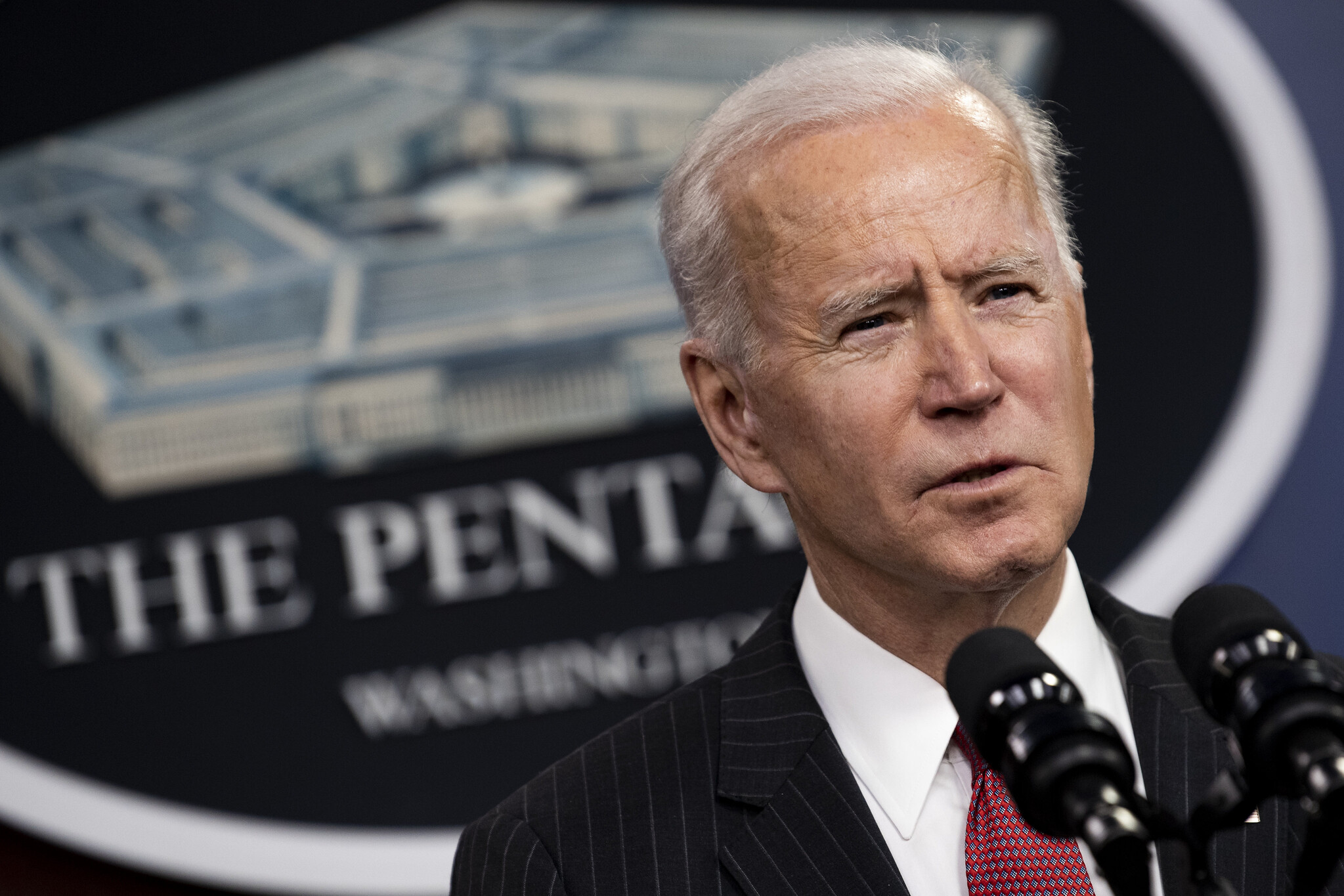
U.S. President Joe Biden at the Department of Defense in Washington, D.C., Feb. 10, 2021. (DoD, Lisa Ferdinando)
By Michael T. Klare
TomDispatch.com
 The word “encirclement” does not appear in the 2022 National Defense Authorization Act (NDAA), signed into law by President Joe Biden on Dec. 27, or in other recent administration statements about its foreign and military policies. Nor does that classic Cold War era term “containment” ever come up. Still, America’s top leaders have reached a consensus on a strategy to encircle and contain the latest great power, China, with hostile military alliances, thereby thwarting its rise to full superpower status.
The word “encirclement” does not appear in the 2022 National Defense Authorization Act (NDAA), signed into law by President Joe Biden on Dec. 27, or in other recent administration statements about its foreign and military policies. Nor does that classic Cold War era term “containment” ever come up. Still, America’s top leaders have reached a consensus on a strategy to encircle and contain the latest great power, China, with hostile military alliances, thereby thwarting its rise to full superpower status.
The gigantic 2022 defense bill — passed with overwhelming support from both parties — provides a detailed blueprint for surrounding China with a potentially suffocating network of U.S. bases, military forces, and increasingly militarized partner states. The goal is to enable Washington to barricade that country’s military inside its own territory and potentially cripple its economy in any future crisis. For China’s leaders, who surely can’t tolerate being encircled in such a fashion, it’s an open invitation to… well, there’s no point in not being blunt… fight their way out of confinement.
Like every “defense” bill before it, the $768 billion 2022 NDAA is replete with all-too-generous handouts to military contractors for favored Pentagon weaponry. That would include F-35 jet fighters, Virginia-class submarines, Arleigh Burke-class destroyers, and a wide assortment of guided missiles. But as the Senate Armed Services Committee noted in a summary of the bill, it also incorporates an array of targeted appropriations and policy initiatives aimed at encircling, containing, and someday potentially overpowering China. Among these are an extra $7.1 billion for the Pacific Deterrence Initiative, or PDI, a program initiated last year with the aim of bolstering U.S. and allied forces in the Pacific.
Nor are these just isolated items in that 2,186-page bill. The authorization act includes a “sense of Congress” measure focused on “defense alliances and partnerships in the Indo-Pacific Region,” providing a conceptual blueprint for such an encirclement strategy. Under it, the secretary of defense is enjoined to “strengthen United States defense alliances and partnerships in the Indo-Pacific region so as to further the comparative advantage of the United States in strategic competition with the People’s Republic of China,” or PRC.
That the 2022 National Defense Authorization Act passed with no significant opposition in the House or Senate suggests that support for these and similar measures is strong in both parties. Some progressive Democrats had indeed sought to reduce the size of military spending, but their colleagues on the House and Senate Armed Services Committees instead voted to increase this year’s already staggering allotment for the Pentagon by another $24 billion — specifically to better contain (or fight) China.
Most of those added taxpayer dollars will go toward the creation of hypersonic missiles and other advanced weaponry aimed at the PRC, and increased military exercises and security cooperation with U.S. allies in the region.
For Chinese leaders, there can be no doubt about the meaning of all this: whatever Washington might say about peaceful competition, the Biden administration, like the Trump administration before it, has no intention of allowing the PRC to achieve parity with the United States on the world stage. In fact, it is prepared to employ every means, including military force, to prevent that from happening.
This leaves Beijing with two choices: succumb to U.S. pressure and accept second-class status in world affairs or challenge Washington’s strategy of containment. It’s hard to imagine that country’s current leadership accepting the first choice, while the second, were it adopted, would surely lead, sooner or later, to armed conflict.
The Enduring Lure of Encirclement
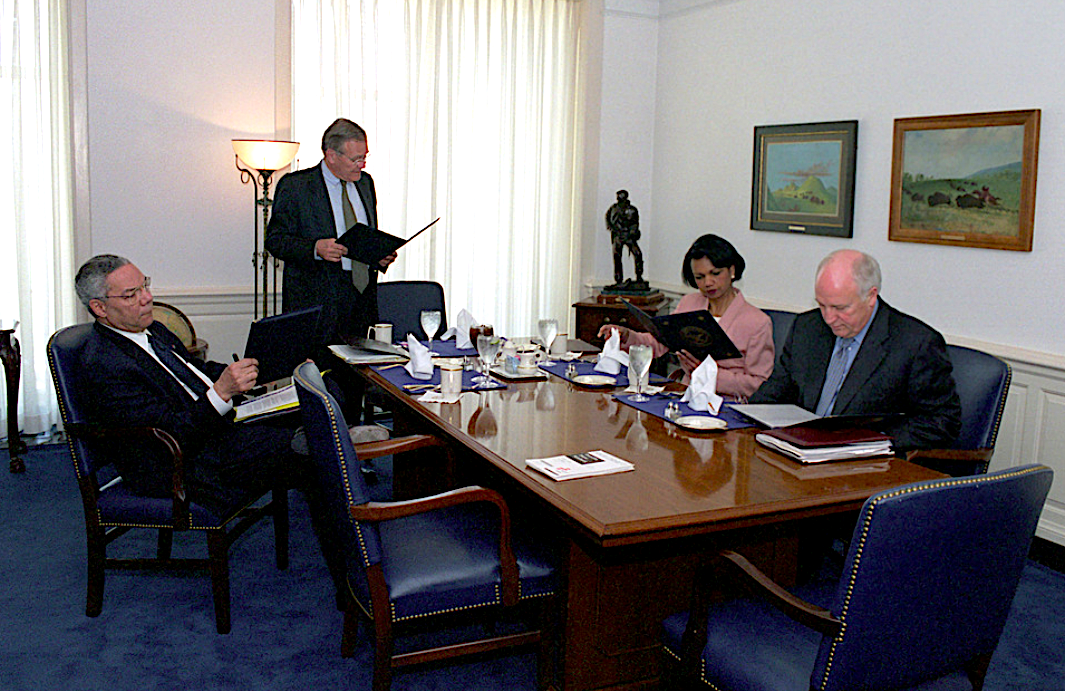
May 2, 2001: U.S. Defense Secretary Donald Rumsfeld, center, hosts a working lunch with, from left, U.S. Secretary of State Colin Powell, U.S. National Security Advisor Condoleezza Rice and U.S. Vice-President, Dick Cheney, in Washington, D.C. (National Archives, Helene C. Stikkel)
The notion of surrounding China with a chain of hostile powers was, in fact, first promoted as official policy in the early months of President George W. Bush’s administration. At that time, Vice President Dick Cheney and National Security Advisor Condoleezza Rice went to work establishing an anti-China alliance system in Asia, following guidelines laid out by Rice in a January 2000 article in Foreign Affairs.
There, she warned of Beijing’s efforts to “alter Asia’s balance of power in its own favor” — a drive the U.S. must respond to by deepening “its cooperation with Japan and South Korea” and by “maintain[ing] its commitment to a robust military presence in the region.” It should, she further indicated, “pay closer attention to India’s role in the regional balance.”
This has, in fact, remained part of the governing U.S. global playbook ever since, even if, for the Bush team, its implementation came to an abrupt halt on September 11, 2001, when Islamic militants attacked the Twin Towers in New York City and the Pentagon in Washington, D.C., leading the administration to declare a “global war on terror.”
Only a decade later, in 2011, did official Washington return to the Rice-Cheney strategy of encircling China and blunting or suppressing its growing power. That November, in an address to the Australian Parliament, President Obama announced an American “pivot to Asia” — a drive to restore Washington’s dominance in the region, while enlisting its allies there in an intensifying effort to contain China.
“As president, I have… made a deliberate and strategic decision,” Obama declared in Canberra. “As a Pacific nation, the United States will play a larger and long-term role in shaping this region and its future… As we end today’s wars [in the Middle East], I have directed my national security team to make our presence and mission in the Asia Pacific a top priority.”
Support CN’s Winter Fund Drive!
Like the Bush team before it, however, the Obama administration was blindsided by events in the Middle East, specifically the 2014 takeover of significant parts of Iraq and Syria by the Islamic State, and so was forced to suspend its focus on the Pacific. Only in the final years of the Trump administration did the idea of encircling China once again achieve preeminence in U.S. strategic thinking.
Led by Secretary of State Mike Pompeo, the Trump effort proved far more substantial, involving as it did the beefing-up of U.S. forces in the Pacific; closer military ties with Australia, Japan, and South Korea; and an intensified outreach to India. Pompeo also added several new features to the mix: a “quadrilateral” alliance between Australia, India, Japan, and the U.S. (dubbed the “Quad,” for short); increased diplomatic ties with Taiwan; and the explicit demonization of China as an enemy of Western values.
In a July 2020 speech at the Richard Nixon Presidential Library, Pompeo laid out the new China policy vividly. To prevent the Chinese Communist Party (CCP) from demolishing “the rules-based order that our societies have worked so hard to build,” he declared, we must “draw common lines in the sand that cannot be washed away by the CCP’s bargains or their blandishments.” This required not only bolstering U.S. forces in Asia but also creating a NATO-like alliance system to curb China’s further growth.
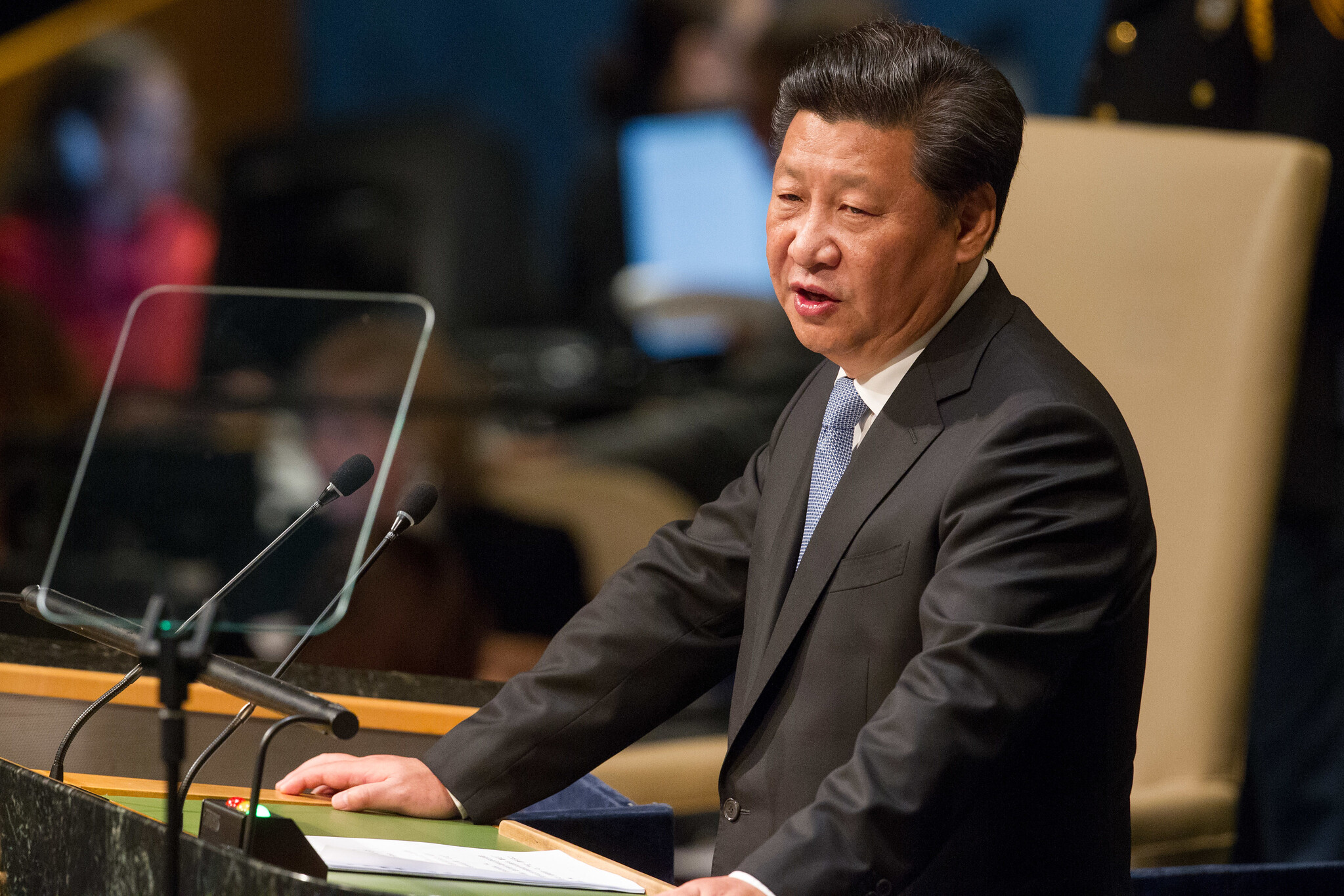
Chinese President Xi Jinping addressing UN Genera Assebly in 2015. (UN Photo/Loey Felipe)
Pompeo also launched two key anti-China initiatives: the institutionalization of the Quad and the expansion of diplomatic and military relations with Taiwan. The Quad, or Quadrilateral Security Dialogue as it’s formally known, had initially been formed in 2007 by Japanese Prime Minister Shinzo Abe (with the support of Vice President Dick Cheney and the leaders of Australia and India), but fell into abeyance for years. It was revived, however, in 2017 when Australian Prime Minister Malcolm Turnbull joined Abe, Indian Prime Minister Narendra Modi, and Donald Trump in promoting a stepped-up effort to contain China.
As for Taiwan, Pompeo upped the ante there by approving diplomatic missions to its capital, Taipei, by senior officials, including Health Secretary Alex Azar and Undersecretary of State Keith Krach, the highest-ranking members of any administration to visit the island since 1979, when Washington severed formal relations with its government. Both visits were roundly criticized by Chinese officials as serious violations of the commitments Washington had made to Beijing under the agreement establishing ties with the PRC.
Biden Adopts the Encirclement Agenda
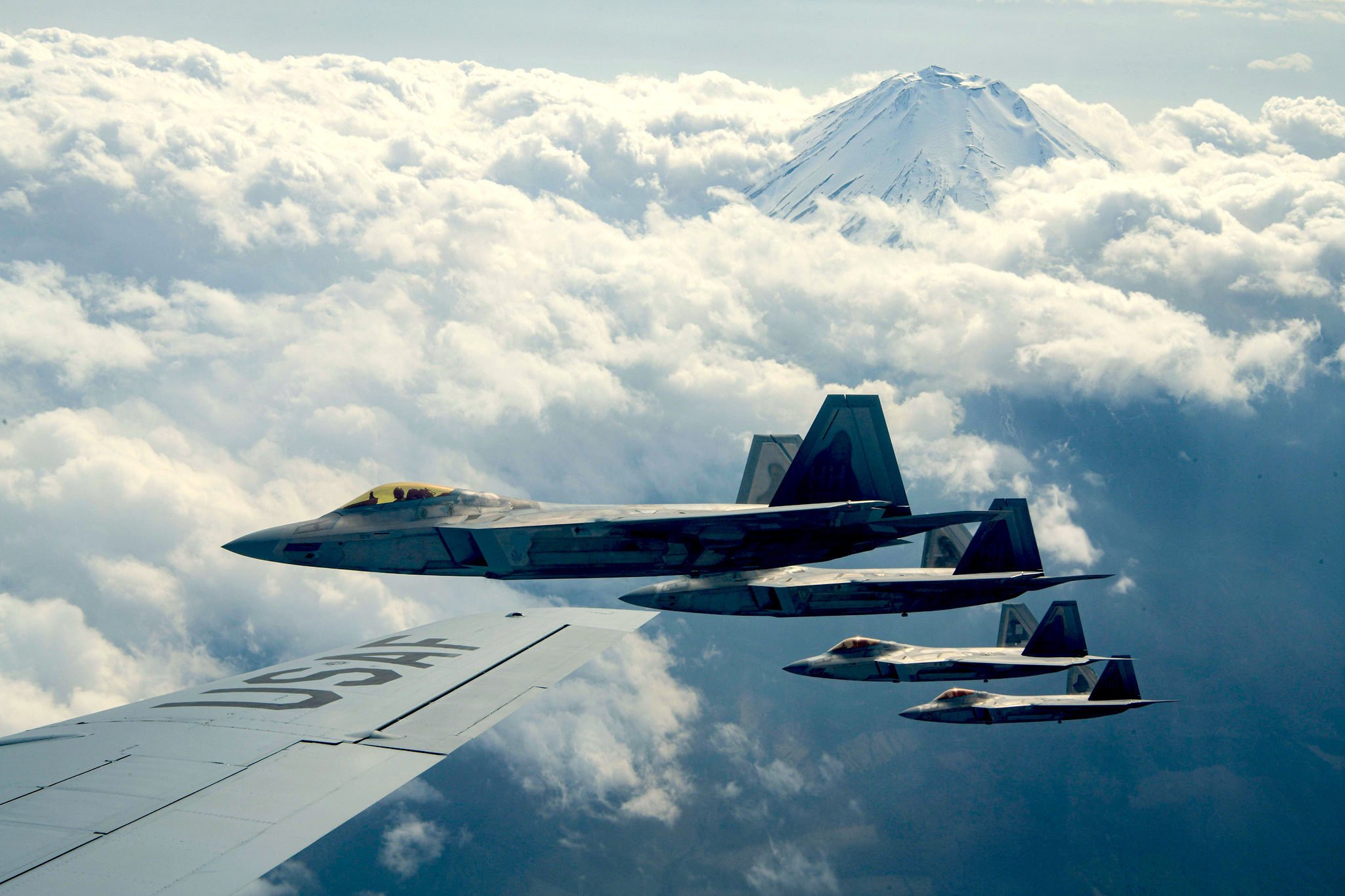
April 1, 2021: U.S. military aircraft in training near Mt. Fuji, Japan. (U.S. Air Force, Rebeckah Medeiros)
On entering the White House, President Biden promised to reverse many of the unpopular policies of his predecessor, but strategy towards China was not among them. Indeed, his administration has embraced the Pompeo encirclement agenda with a vengeance. As a result, ominously enough, preparations for a possible war with China are now the Pentagon’s top priority as, for the State Department, is the further isolation of Beijing diplomatically.
In line with that outlook, the Defense Department’s 2022 budget request asserted that “China poses the greatest long-term challenge to the United States” and, accordingly, that “the Department will prioritize China as our number one pacing challenge and develop the right operational concepts, capabilities, and plans to bolster deterrence and maintain our competitive advantage.”
In the meantime, as its key instrument for bolstering ties with allies in the Asia-Pacific region, the Biden administration endorsed Trump’s Pacific Deterrence Initiative. Proposed PDI spending was increased by 132% in the Pentagon’s 2022 budget request, rising to $5.1 billion from the $2.2 billion in 2021. And if you want a measure of this moment in relation to China, consider this: even that increase was deemed insufficient by congressional Democrats and Republicans who added another $2 billion to the PDI allocation for 2022.
To further demonstrate Washington’s commitment to an anti-China alliance in Asia, the first two heads of state invited to the White House to meet President Biden were Japanese Prime Minister Yoshi Suga and South Korean President Moon Jae-in. In talks with them, Biden emphasized the importance of joint efforts to counter Beijing. Following his meeting with Suga, for instance, Biden publicly insisted that his administration was “committed to working together to take on the challenges from China… to ensure a future of a free and open Indo-Pacific.”
On Sept. 24, in a first, leaders of the Quad all met with Biden at a White House “summit.” Although the administration emphasized non-military initiatives in its post-summit official report, the main order of business was clearly to strengthen military cooperation in the region. As if to underscore this, Biden used the occasion to highlight an agreement he’d just signed with Prime Minister Scott Morrison of Australia to provide that country with the propulsion technology for a new fleet of nuclear-powered submarines — a move obviously aimed at China. Note as well that, just days before the summit, the administration formed a new alliance with Australia and the United Kingdom, called AUKUS, and again aimed at China.
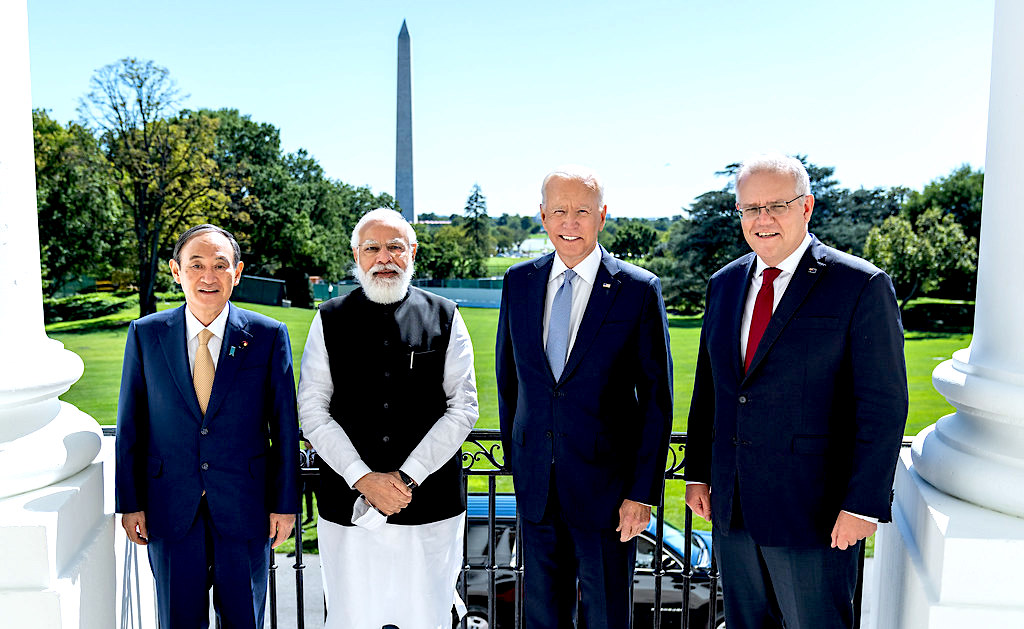
Quad leaders in Wahington on Sept. 24, 2021, from left: Japanese Prime Minister Yoshihide Suga, India Prime Minister Narendra Modi, U.S. President Joe Biden and Australian Prime Minister Scott Morrison. (White House, Adam Schultz)
Finally, Biden has continued to increase diplomatic and military contacts with Taiwan, beginning on his first day in office when Hsiao Bi-khim, Taipei’s de facto ambassador to Washington, attended his inauguration. “President Biden will stand with friends and allies to advance our shared prosperity, security, and values in the Asia-Pacific region — and that includes Taiwan,” a top administration official said at the time. Other high-level contacts with Taiwanese officials, including military personnel, soon followed.
‘Grand Strategy’ for Containment
What all these initiatives have lacked, until now, is an overarching plan for curbing China’s rise and so ensuring America’s permanent supremacy in the Indo-Pacific region. The authors of this year’s NDAA were remarkably focused on this deficiency and several provisions of the bill are designed to provide just such a master plan. These include a series of measures intended to incorporate Taiwan into the U.S. defense system surrounding China and a requirement for the drafting of a comprehensive “grand strategy” for containing that country on every front.
A “sense of Congress” measure in that bill provides overarching guidance on these disparate initiatives, stipulating an unbroken chain of U.S.-armed sentinel states — stretching from Japan and South Korea in the northern Pacific to Australia, the Philippines, Thailand, and Singapore in the south and India on China’s eastern flank — meant to encircle and contain the People’s Republic. Ominously enough, Taiwan, too, is included in the projected anti-China network.
That island’s imagined future role in such an emerging strategic plan was further spelled out in a provision entitled “Sense of Congress on Taiwan Defense Relations.” Essentially, this measure insists that Washington’s 1978 pledge to terminate its military ties with Taipei and a subsequent 1982 U.S.-China agreement committing this country to reduce the quality and quantity of its arms transfers to Taiwan are no longer valid due to China’s “increasingly coercive and aggressive behavior” toward the island.
Accordingly, the measure advocates closer military coordination between the two countries and the sale of increasingly sophisticated weapons systems to Taiwan, along with the technology to manufacture some of them.
Add all this up and here’s the new reality of the Biden years: the disputed island of Taiwan, just off the Chinese mainland and claimed as a province by the PRC, is now being converted into a de facto military ally of the United States. There could hardly be a more direct assault on China’s bottom line: that, sooner or later, the island must agree to peacefully reunite with the mainland or face military action.
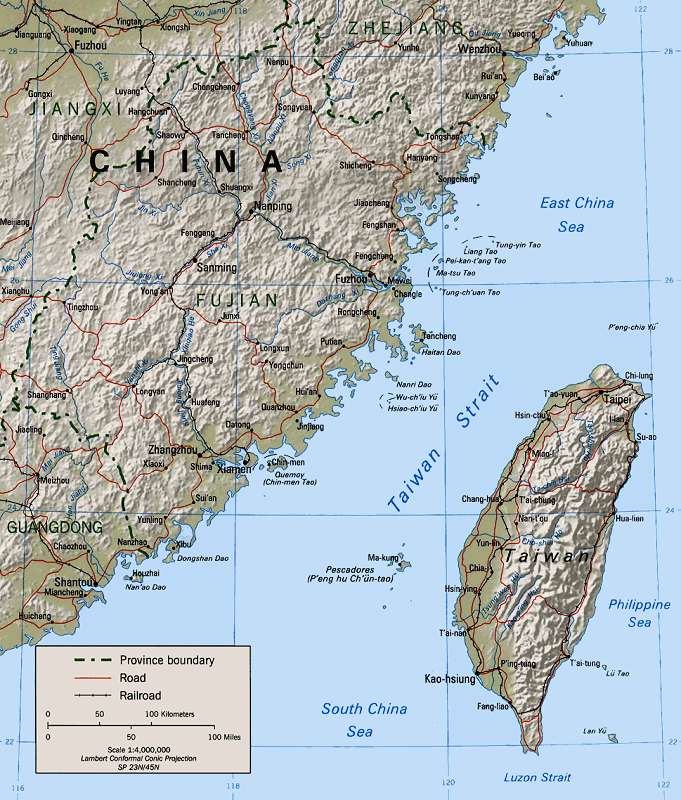
Map of the Taiwan Strait. (Wikimedia Commons)
Recognizing that the policies spelled out in the 2022 NDAA represent a fundamental threat to China’s security and its desire for a greater international role, Congress also directed the president to come up with a “grand strategy” on U.S.-China relations in the next nine months. This should include an assessment of that country’s global objectives and an inventory of the economic, diplomatic, and military capabilities the U.S. will require to blunt its rise.
In addition, it calls on the Biden administration to examine “the assumptions and end-state or end states of the strategy of the United States globally and in the Indo-Pacific region with respect to the People’s Republic of China.” No explanation is given for the meaning of “end-state or end states,” but it’s easy to imagine that the authors of that measure had in mind the potential collapse of the Chinese Communist government or some form of war between the two countries.
How will Chinese leaders react to all this? No one yet knows, but President Xi Jinping provided at least a glimpse of what that response might be in a July 1st address marking the 100th anniversary of the founding of the Chinese Communist Party. “We will never allow any foreign force to bully, oppress, or subjugate us,” he declared, as China’s newest tanks, rockets, and missiles rolled by. “Anyone who would attempt to do so will find themselves on a collision course with a great wall of steel forged by over 1.4 billion Chinese people.”
Welcome to the new 21st century Cold War on a planet desperately in need of something else.
Michael T. Klare, a TomDispatch regular, is the five-college professor emeritus of peace and world security studies at Hampshire College and a senior visiting fellow at the Arms Control Association. He is the author of 15 books, the latest of which is All Hell Breaking Loose: The Pentagon’s Perspective on Climate Change (Metropolitan Books).
This article is from TomDispatch.com.
The views expressed are solely those of the author and may or may not reflect those of Consortium News.
Support CN’s
Winter Fund Drive!
Donate securely with PayPal
Or securely by credit card or check by clicking the red button:


Tnx Michael CN.
Unsure agree w/ premise Obama Adm no encircle policy.
Belt & Road intro 2013… Article states appx 1 adm (yrs) between Carter pledge & Reagan agreement.
Current US Gov Nuclear re-develop plan 10 yrs duration…
The last time the US fought China (in Korea) they had to accept a draw – and that was when China was not nearly so well equipped as the US/NATO armies, and the US had recently been trained and experienced in the war against Japan. China at one point had them corralled into a small part of Korea.
This time, the Chinese are actually better or equal in equipment, while the US has warship Captains who habitually run into civilian ships, and a first line fighter (F35) which can neither fight or run away.
Goodbye to the Evil Empire.
The rank, stinking hypocrisy of the USUK’s warmongering against China is sickening. Not least is when we compare the opposing approaches to the pandemic. In the USUK there have been well over a million deaths so far and the two governments are doing close to nothing to prevent far more, solely in the interests of protecting capital accumulation. In China there have been close to no deaths at all since the start of the pandemic. Yes, that required enormous levels of state action allied to community cooperation (which has been, it seems, enthusiastic on a scale impossible to comprehend here in the UK). But it saved probably millions of lives. For our governments to be telling us to prepare for war against that nation is detestable.
I recall similar “containment” of Japan, before they too, struck out in protest. Looks like the aggressors learn nothing from history, and are deliberately seeking confrontation.
The US government had better muster any remaining power they have to shore up their own declining fortunes, and not waste it on trying to bring down China. China has a large, well-educated populace, excellent technology, and a functioning government that can get things done. The US only has sociopathy and nukes. They can bring down China only by destroying the whole world. Let’s hope they don’t do that.
The Incompetent Evil Empire is in serious decline. No one’s buying their bullshit anymore.
Surely someone in the Biden maladministration must see how absurd it is to confront and rule both China and Russia, and as a joint alliance of those two at their greatest strength. The reason is nothing but hubris, with the USA using its personal rules based order “do as we order you or be punished,” as if it is a valid plan for the future.
High time to teach the US a lesson it won’t forget so quickly. This constant fear mongering, constant war mongering…is this what a ‘leader of the world’ looks like? Heaven help us.
SPOT ON Vera.
A vote for Biden is a vote for a new Cold War. A Cold War even more dangerous than the one we spent nearly 50 years on a knife edge trying to escape. What the world at home and abroad completely misunderstand, the “fundamental lie” being promoted, is that Biden and the Democrats are more rational than Trump and the Republicans. In reality, ten minutes after Biden was elected, he has us headed for WWIII. “Hell of a job..,” or perhaps the job of hell.
We dodged a bullet when HRC lost to Trump. Can you imagine where we would be now? It’s not that the GOP is better. Trump’s biggest gift to all of us was/is his incompetence. HRC was nothing less than competent, but competent in service of what? Now that becomes blindingly clear as a fact. Folksy Biden does not appear as rabid as HRC but he, and the DP, are in effect no different than she. And here, after four years in which we managed to avoid ratcheting up a new Cold/Hot War through blind luck or incompetent management, is where we are again. Once more with humanity in the center of the bullseye. Oh great, “America is back…”
At a moment, with absolutely no time left, when the world needs all the cooperation it can possibly manage, here is America again making that impossible. All the while the temperature continues to rise. And the Democrats are supposed to be the smart ones, the rational ones… right. I imagine that the world is starting, finally perhaps, to make note that it is not only the “crazy Republicans” who pose a threat to life on this planet. It is in fact America itself that is the threat. Cheers of “America is back” made my blood run cold and this is exactly why.
A vote for any president, regardless of party affiliation, is a vote for war. America knows no other way. Founded in war, & sustained by war, it is all it knows.
rgl: Indeed. Thus we are faced with the ironic situation whereby the more incompetent the administration, the better off we are since the entire mechanism of US government is directed toward this perverse end. It is certainly not directed toward improving the lives of American citizens. Biden and HRC are certainly competent when it comes to moving toward war, apparently more so than Trump, which is what makes Biden and the Dems especially dangerous.
That is why I preferred Trump to Hillary Clinton: he was the more incompetent war criminal. Anyway, I voted for Jill Stein, and I would do it again.
Jon Adams: Yes, thanks. The same for me. Now though, if Biden & Co. run again, or if the DP remains as it is, I will even contemplate voting repub just to stop them. Have never voted repub in my life, not since the hardhats of the Vietnam era but based on Biden’s actions I am seriously considering it now. Asking politely for change since their tilting the primaries in 2016 crystalized their intent has not worked at all. As for the DP base, a lost cause. They are apparently fine with whatever the DP leadership does to them, and us. I thought it was the GOP that was the enemy of the world. Now we know it’s the DP just as well and with different competencies. The GOP pushes more extremely to the totalitarian right, the DP play acts some weak opposition and then the DP comes to power and normalizes it. And so the wheel keeps on turning, in the worst direction.
If the DP is hell bent on starting a new Cold or Hot War for their elite donors, fuck em, however I can.
This is the road to world war redux. The real new “Hitler” actually resides in Washington. The imbeciles in power need to be extracted from office somehow, even if elections cannot get the job done. They are crushing any future our citizenry could hope for with their lust for absolute power. And, frankly, the human beings in other countries have the right to live as well even if their existence is inconvenient for American warmongers. Our leaders are being as outrageous as any tyrant who ever lived. We must not support them! I’m sorry but this alleged “rules-based order” that American warmongers claim does NOT trump morality and cannot be used as an excuse for their grab at planet-wide domination. Why don’t they just admit that their real policy is “might makes right?”
“For Chinese leaders, there can be no doubt about the meaning of all this: whatever Washington might say about peaceful competition, the Biden administration, like the Trump administration before it, has no intention of allowing the PRC to achieve parity with the United States on the world stage. In fact, it is prepared to employ every means, including military force, to prevent that from happening.”
A multi-polar world and U.S. imperialism are mutually exclusive. By definition. Chinese parity/free competition with the U.S. would entail the demise of the dollar as the global reserve currency, which in turn would mean no more free lunch for U.S. imperialists.
“In addition, it [the 2022 NDAA] calls on the Biden administration to examine ‘the assumptions and end-state or end states of the strategy of the United States globally and in the Indo-Pacific region with respect to the People’s Republic of China.’”
The U.S. “end-state”/endgame is a ruthless globe-spanning plutocracy enforced by the U.S. military.
That’s the dream and ambition behind U.S. foreign policy. Too bad that dream is everyone else’s worst nightmare.
So who is going to volunteer to be the first to die for a hegemon that is intent on killing its own first? If any survive your (and our) upcoming year of covid variants, hyper impoverishment due to outsized military spending, a potential civil conflict at home and constant shortages of goods and products in your stores and of course, killer climate chaos – will they then go and attempt to survive a war of attrition created by the sheer ignorance of politicians who have never been on the war front? I know I sure wouldn’t and not too many of my fellow citizens in my country wouldn’t. That is a heck of lot of uncontrollable events for us regular citizen to survive much less actively seeking out further methods leading to death. It might just be better to just try to fix what we can in our own countries without looking for trouble outside it.
Sometimes, I feel like the United States is like a jilted lover who is determined that if he can’t have his lover, no one will: if the USA can’t have the world, no one will.